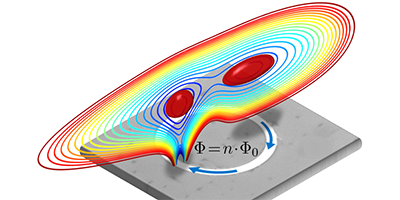Cold Atoms, Meet Flux Quanta
Researchers are working on the development of hybrid quantum technologies that couple different quantum systems, such as cold atoms and superconducting circuits, to combine their respective strengths. Now Patrizia Weiß and colleagues at the University of Tübingen, in Germany, have used a cloud of ultracold atoms to detect discrete quanta of magnetic flux produced by a nearby superconducting ring. The researchers say that this result could lead to new kinds of quantum information devices, in which, for instance, a cold-atom cloud acts as a memory for the information processed by a superconducting circuit.
In the experiment, the team first applied a constant magnetic field while cooling down a 20-micrometer-wide niobium ring on a sapphire chip to a temperature below the superconducting transition. They then used additional magnetic fields to trap an ultracold rubidium cloud 18 micrometers below the ring. Since the ring’s magnetic field changed the shape (well depth) of the atom trap, it affected the number of trapped atoms. Finally, the team measured the laser absorption of the cloud to determine the number of atoms.
The magnetic flux threading a superconducting ring is always an integer multiple of the fundamental flux quantum, Planck’s constant divided by twice the electron charge ( h/2e). Repeating the experiment with different magnetic field strengths, the authors found that the number of atoms changed with increasing field in discrete “jumps,” rather than continuously. The jump size matched predictions, suggesting that the jumps directly indicate the number of flux quanta in the ring.
This research is published in Physical Review Letters.
–David Ehrenstein





